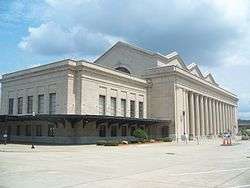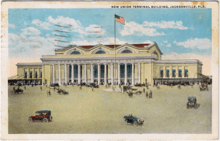Prime F. Osborn III Convention Center
| Prime F. Osborn III Convention Center | |
|---|---|
 | |
| Address | 1000 Water Street |
| Location | Jacksonville, Florida |
| Coordinates | 30°19′40″N 81°40′17″W / 30.32788°N 81.6713°WCoordinates: 30°19′40″N 81°40′17″W / 30.32788°N 81.6713°W |
| Owner | City of Jacksonville |
| Built | 1919 |
| Opened | October 17, 1986 |
Former names | Union Station |
| Enclosed space | |
| • Total space | 265,000 sq ft (24,600 m2) |
| • Exhibit hall floor | 78,500 sq ft (7,290 m2) |
| Public transit access |
Monorail: Convention Center Station Northbank Line |
| Website | |
|
Jacksonville Terminal Complex | |
  | |
| Location | Jacksonville, Florida |
| Architect | Murchison,Kenneth M., Howe,W.B.W. |
| Architectural style | Beaux-Arts |
| NRHP Reference # | 76000590[1] |
| Added to NRHP | 1976 |
Prime F. Osborn III Convention Center is a 265,000-square-foot (24,600 m2) convention center located in downtown Jacksonville, Florida. Opened in 1986, it was built incorporating Jacksonville's Union Station as well as several thousand square feet of newly built structure.
Located in the Jacksonville neighborhood of LaVilla, the Prime Osborn contains two exhibition halls totaling 78,500 square feet (7,290 m2), several ballrooms and meetings rooms. The City of Jacksonville is looking to replace the Prime Osborn within the next decade, with a larger 500,000+ square foot convention center in downtown Jacksonville. The Convention Center station of the JTA Skyway is located across the street.
History

LaVilla, at that time a suburb of Jacksonville, was for many years an important railroad hub. The first union station in the area was built by the Savannah, Florida and Western Railway (later part of the Atlantic Coast Line Railroad) in 1883. The Jacksonville, Tampa and Key West Railway (also later part of the ACL) began to use it in 1884. Other terminals served the Florida Central and Peninsular Railroad (later part of the Seaboard Air Line Railway), the Florida East Coast Railway, and the Georgia Southern and Florida Railway.
The company was incorporated in 1894 by Henry Flagler, who owned the Florida East Coast Railway. Its first Union Depot opened on February 4, 1895, and was completed on January 15, 1897. It came to be known as the Flagler Depot. Ownership was split between five railroad companies, Atlantic Coast Line Railroad, Florida East Coast Railway, and Seaboard Air Line Railway each with 25% ownership, Southern Railway and Georgia Southern and Florida Railway each with 12.5% ownership.

When the second Union Station opened in 1919 (on the site of the original one), it was the largest railroad station in the South. At its peak, the terminal handled as many as 142 trains and 20,000 passengers a day.[2] Some of the passenger trains handled in Jacksonville were 18 to 22 railcars long. Within the terminal, there was a restaurant, snack bars, news stands, a barber shop, florist, a drug store, and gift shops.[3] The Jacksonville terminal had 32 tracks. 29 of those tracks were passenger tracks with platforms. Of those, 1-15 were stub or "head" tracks, which ended at the bumper posts. (Some of these massive decorative concrete posts still stand within the Convention Center Concourse).
The station was last used on January 3, 1974; Amtrak moved to a new Jacksonville station several miles north. In 1982, a public-private partnership was started, led by former CSX chairman Prime F. Osborn III. The new convention center opened on October 17, 1986.
Future and proposed projects
The Jacksonville Regional Transit Center is a proposed conversion of a portion of the convention center back into a rail station. the Jacksonville Transportation Authority (JTA) plans to convert and restore the historic terminal building and re-open it for passengers. Amtrak, Florida East Coast Railway, the Skyway, and eventually commuter rail would serve the station.
First Coast Commuter Rail is a proposed passenger rail system serving Jacksonville, FL and the Northeast Florida region. It is currently in the early planning stages. Three routes were analyzed in depth: north to Yulee, FL, southwest to Green Cove Springs, FL, and southeast to St. Augustine, FL.[4]
Gallery
.jpg)
 Bay Street exterior facade
Bay Street exterior facade

 Bay Street East
Bay Street East
See also
- Architecture of Jacksonville
- List of convention centers in the United States
- Northeast Florida Commuter Rail
External links
-
 Media related to Union Station (Jacksonville) at Wikimedia Commons
Media related to Union Station (Jacksonville) at Wikimedia Commons - Prime F. Osborn III Convention Center
References
- ↑
- ↑ http://www.metrojacksonville.com/article/2010-jan-lost-jacksonville-union-terminal
- ↑ http://www.flarr.com/jtc.htm
- ↑ Feasibility Study Final Report